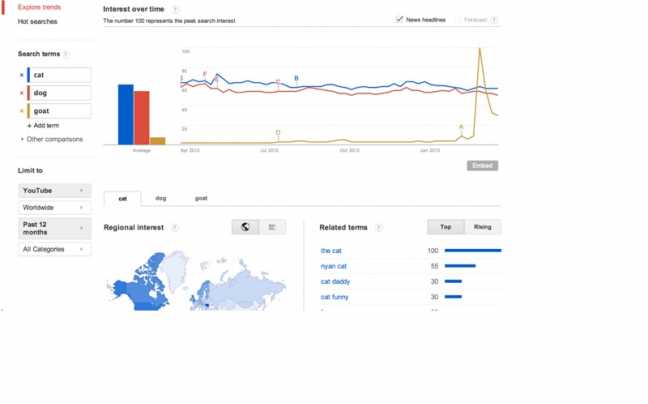Google Trends, the stellar tool that reveals hot topic keyword searches to crafty SEO experts, has officially launched a game changer: users can now track any and all searches on YouTube. Why is this so significant?
YouTube has arguably been the second largest search engine for many years now, behind mighty Google but often way ahead of Yahoo and Bing. Now that YouTube has announced their support from Google Trends, marketers and curious netizens can now learn all they ever wanted to know about YouTube’s user searches. This gives experts a new bird’s eye view into the search habits of users on the mega-site, which to video content creators and marketers is a godsend.
How to Use the New Feature
If you haven’t yet used Google Trends, you’re missing out. It’s one of Google’s most intuitive and useful tools. To access the new YouTube data, launch the site, plot a search and find the “limit to” option on the left hand side. Select “YouTube” and feast on the results. You can choose to examine trends across all of Google and YouTube, or narrow your research strictly to YouTube only. You can also segment by region or category.
SEO professionals use Google Trends regularly to help chart the ideal keywords for their target businesses. They can test to see how prevalent currently used search terms are, and see up-to-the-minute results for other potential searches as well, to guarantee their content is well-matched with the exact things users are after. Trends is a fantastic way to get a legitimate feel for what people are searching for, and to determine how best to optimize your own sites for top Google rankings. Now that video data is included, Trends has become a must-have tool for any and all content publishers.
Consequences of the Merger
Before YouTube searches were tracked by Google Trends, video publishers relied on educated guesses and limited research to help decide how to position their content. With the new content marriage, watch for YouTube creators to quickly ascertain how best to name their videos in order to reach the maximum number of avid watchers. Overall, this is good news for users, as it will encourage publishers to be a lot more polished and professional in naming and describing their content.
Now, publishers can actually search to see what people are looking for in relation to videos and create content focused around what’s hot. In the world of YouTube, most trends that reach maximum popularity do so through a serious of spikes, then begin to taper off. Close examination of recent data will help to reveal if current trends are still at their peak, or are starting to dissipate. These metrics will take a tremendous amount of guesswork out of the video marketing process.
Highlights of the YouTube Data
Google added YouTube trends that go as far back as 2008, so SEO folks can get a great grasp on the old and the new. Having access to historical performance trends makes the data even more useful, for obvious reasons.
Early trend results prove that assumptions about what’s hot and what’s not are anything but obvious. For example, given a list of cats, dogs and goats, which would you assume is currently seeing the most traction? If you guessed cats, the obvious internet darlings, you would be sadly incorrect. Goats are currently the cat’s meow – just look at this chart for proof (and visit this screaming goat video to see what started the madness to begin with.)

If you didn’t see goats taking center stage, you’re likely fully aware of how useful these analytics will be when considering what videos your business should be investing in. Marketers, despite their best efforts, cannot always have their fingers on the pulse of their customers’ needs. The less we have to guess about what our demographic is after, the more successful we can be in delivering a win-win.
Tips for Making the Most of the Information
If you want to truly get an edge on your competition, use the new YouTube data in Google Trends through a long-term strategy – don’t just run a few queries in real-time and assume you’ve solved any SEO riddles. As mentioned above, the data goes back five years to 2008, so take the time to plot multiple relevant searches for your target keywords, and see how they have trended over time. You may see significant spikes around certain week, month or yearly time periods (obvious for seasonal content like Christmas trees, less obvious for screaming goats, but there may just be a time-based correlation to popularity.) As with any metrics, studying the data as it changes over an extended time period, tells a much more accurate and valuable story than simple small-window snapshots.
Regardless of how you choose to use the new YouTube data, there’s no argument that the world of SEO just became even more intriguing. Considering what a behemoth search engine YouTube truly is, it’s now easier for video gurus to create the content their audience wants to see, and use the keyword monikors to attract the right visitors too. It remains to be seen how the tone and structure of YouTube will change now that brilliant SEO minds are on the scene, if at all, but utlimately, this addition is great for users and business owners alike. If YouTubers want more goat videos, video creators are now keenly aware. You know the cardinal rule — give the people what they want. Google Trends is now the ultimate tool to demystify this adage in the world of online videos.
source: http://www.sitepronews.com

